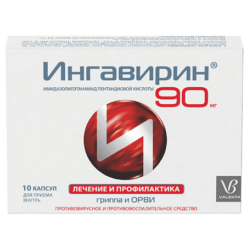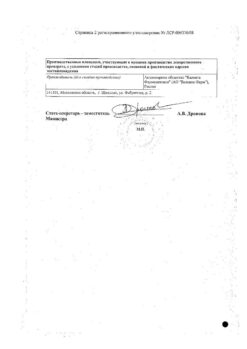No products in the cart.
Description
Antiviral drug.
In preclinical and clinical studies demonstrated the efficacy of Ingavi-rin® against influenza viruses of type A (A(H1N1), including pandemic strain A(H1N1)pdm09 (“pig”), A(H3N2), A(H5N1)) and type B, adenovirus, parainfluenza virus, respiratory syncytial virus; in preclinical studies: coronavirus, metapneumovirus, enteroviruses, including coxsackievirus and rhinovirus.
Ingavirin® reduces the viral load, accelerates viral elimination, reduces the duration of the disease, and decreases the risk of complications. The mechanism of action is realized at the level of infected cells through activation of the factors of innate immunity suppressed by viral proteins. In experimental studies, in particular, it was shown that Ingavirin® increases the expression of the interferon receptor of the first type IFNAR on the surface of epithelial and immunocompetent cells. Increased density of interferon receptors leads to increased sensitivity of cells to endogenous interferon signals. The process is accompanied by activation (phosphorylation) of protein-transmitter STAT1 transmitting a signal to cell nucleus for induction of antiviral gene synthesis. It was shown that under the conditions of infection the preparation activates synthesis of antiviral effector protein MxA (early antiviral response factor inhibiting intracellular transport of ribonucleoprotein complexes of various viruses) and phosphorylated form of PKR inhibiting translation of viral proteins, thus slowing down and stopping viral reproduction process.
The action of Ingavirin® preparation is based on significant decrease of cytopathic and cytodestructive action of the virus, decrease of the number of infected cells, restriction of the pathological process, normalization of composition and structure of cells and morphological tissue pattern in the infectious process zone both at early and late stages. Anti-inflammatory activity is caused by suppression of production of key pro-inflammatory cytokines (tumor necrosis factor (TNF-α), interleukins (IL-1β and IL-6) and decrease of myeloperoxidase activity.
In experimental studies it is shown that combined use of Ingavirin® with antibiotics increases the effectiveness of therapy in the model of bacterial sepsis including that caused by penicillin-resistant strains of Staphylococcus aureus.
The conducted experimental toxicological studies demonstrate low level of toxicity and high safety profile of the drug.
According to the parameters of acute toxicity Ingavirin® belongs to the 4th class of toxicity – “Low toxic substances” (by determining the LD50 in acute toxicity experiments no lethal doses of the drug were determined).
The preparation possesses no mutagenic, immunotoxic, allergizing and carcinogenic properties. Ingavirin® has no effect on reproductive function, has no embryotoxic and teratogenic action.
There is no effect of Ingavirin® on the hematopoietic system when taking the age-appropriate dose according to the recommended scheme and course
Intake and distribution
In the experiment with the radioactive label it was found that The active ingredient quickly enters the blood from the gastrointestinal tract, distributing to internal organs. In studies in healthy volunteers at a single dose of 90 mg of the drug maximum concentration (Cmax) was 441.45 ± 252.99 ng / ml; time of its achievement (Tmax) – 1.30 ± 0.41 hours.
In preclinical studies it was found that when taking the drug once a day it is accumulated in the internal organs and tissues. At that qualitative characteristics of pharmacokinetic curves after each administration of the preparation are identical: rapid increase of the preparation’s concentration after each injection of 0.5-1 hour after the intake, and then slow decrease by 24 hours. The AUC values (area under the pharmacokinetic curve “concentration-time”) of kidney, liver and lung are slightly higher than the AUC of blood. AUC values for spleen, adrenal glands, lymph nodes and thymus are lower than AUC in blood.
Metabolism
The drug is not metabolized in the body and is excreted unchanged.
Elimation
In studies in healthy volunteers when taking the drug in a single dose of 90 mg, the half-life (T1/2) was 1.82 ± 0.23 hours. In preclinical studies it was found that the main process of excretion occurs within 24 hours. During this period 80 % of the taken dose was eliminated: 34.8 % was eliminated in a time interval from 0 to 5 hours, and 45.2 % in a time interval from 5 to 24 hours. Of these, 77% are excreted through the intestines and 23% through the kidneys.
Indications
Indications
Treatment and prevention of influenza A and B and other acute respiratory viral infections (adenoviral infection, parainfluenza, respiratory syncytial infection, rhinovirus infection) in adults and children over 3 years of age.
Pharmacological effect
Pharmacological effect
Antiviral drug.
Preclinical and clinical studies have shown the effectiveness of the drug Ingavirin® against influenza viruses type A (A(H1N1), including pandemic strain A(H1N1)pdm09 (“swine”), A(H3N2), A(H5N1)) and type B, adenovirus, parainfluenza virus, respiratory syncytial virus; in preclinical studies: coronavirus, metapneumovirus, enteroviruses, including Coxsackie virus and rhinovirus.
Ingavirin® reduces the viral load, accelerates the elimination of viruses, shortens the duration of the disease, and reduces the risk of complications. The mechanism of action is realized at the level of infected cells due to the activation of innate immune factors suppressed by viral proteins. In experimental studies, in particular, it was shown that the drug Ingavirin® increases the expression of the first type interferon receptor IFNAR on the surface of epithelial and immunocompetent cells. An increase in the density of interferon receptors leads to an increase in the sensitivity of cells to signals from endogenous interferon. The process is accompanied by activation (phosphorylation) of the transmitter protein STAT1, which transmits a signal to the cell nucleus to induce the synthesis of antiviral genes. It has been shown that under conditions of infection, the drug activates the synthesis of the antiviral effector protein MxA (an early factor of the antiviral response that inhibits the intracellular transport of ribonucleoprotein complexes of various viruses) and the phosphorylated form of PKR, which suppresses the translation of viral proteins, thus slowing down and stopping the process of viral reproduction.
The effect of the drug Ingavirin® is to significantly reduce the signs of the cytopathic and cytodestructive effects of the virus, reduce the number of infected cells, limit the pathological process, normalize the composition and structure of cells and the morphological picture of tissues in the area of the infectious process, both in its early and late stages. The anti-inflammatory effect is due to the suppression of the production of key pro-inflammatory cytokines (tumor necrosis factor (TNF-α), interleukins (IL-1β and IL-6)), and a decrease in the activity of myeloperoxidase.
Experimental studies have shown that the combined use of the drug Ingavirin® with antibiotics increases the effectiveness of therapy in a model of bacterial sepsis, including that caused by penicillin-resistant strains of staphylococcus.
Experimental toxicological studies conducted indicate a low level of toxicity and a high safety profile of the drug.
According to the parameters of acute toxicity, the drug Ingavirin® belongs to toxicity class 4 – “Low toxic substances” (when determining LD50 in acute toxicity experiments, lethal doses of the drug could not be determined).
The drug does not have mutagenic, immunotoxic, allergenic or carcinogenic properties, and does not have a local irritant effect. The drug Ingavirin® does not affect reproductive function and does not have embryotoxic or teratogenic effects.
There is no effect of the drug Ingavirin® on the hematopoietic system when taking the age-appropriate dose in the recommended regimen and course
Suction and distribution
In an experiment using a radioactive label, it was established that the active substance quickly enters the blood from the gastrointestinal tract, distributing throughout the internal organs. In a study in healthy volunteers, with a single dose of 90 mg, the maximum concentration (Cmax) was 441.45 ± 252.99 ng/ml; time to achieve it (Tmax) – 1.30 ± 0.41 hours.
In preclinical studies, it was found that with a course of taking the drug once a day, it accumulates in internal organs and tissues. At the same time, the qualitative characteristics of the pharmacokinetic curves after each administration of the drug are identical: a rapid increase in the concentration of the drug after each administration 0.5-1 hour after administration and then a slow decrease by 24 hours. The AUC values (area under the concentration-time pharmacokinetic curve) of the kidneys, liver and lungs are slightly higher than the AUC of blood. AUC values for the spleen, adrenal glands, lymph nodes and thymus are lower than blood AUC.
Metabolism
The drug is not metabolized in the body and is excreted unchanged.
Removal
In a study in healthy volunteers, with a single dose of 90 mg, the half-life (T1/2) was 1.82 ± 0.23 hours. In preclinical studies, it was found that the main elimination process occurs within 24 hours. During this period, 80% of the dose taken is excreted: 34.8% is excreted in the time interval from 0 to 5 hours and 45.2% in the time interval from 5 to 24 hours. Of these, 77% is excreted through the intestines and 23% through the kidneys.
Special instructions
Special instructions
It is not recommended to take other antiviral drugs at the same time without first consulting a doctor.
Save the instructions. It may be needed again. If you have any questions, consult your doctor.
Active ingredient
Active ingredient
Pentanedioic acid imidazolylethanamide
Composition
Composition
5 ml of syrup contains:
active ingredient:
imidazolylethanamide pentanedioic acid – 30 mg;
excipients: maltitol (liquid maltitol), glycerol, citric acid monohydrate, xanthan gum, sodium methyl parahydroxybenzoate, pear flavor, purified water.
Pregnancy
Pregnancy
The use of the drug during pregnancy has not been studied.
The use of the drug during lactation has not been studied, therefore, if it is necessary to use the drug during breastfeeding, breastfeeding should be discontinued.
Contraindications
Contraindications
Hypersensitivity to the active substance or any other component of the drug.
Sucrase/isomaltase deficiency, fructose intolerance, glucose-galactose malabsorption.
Pregnancy.
Breastfeeding period.
Children under 3 years of age.
Side Effects
Side Effects
Allergic reactions (rare).
If any of the side effects indicated in the instructions get worse or you notice any other side effects not listed in the instructions, tell your doctor.
Interaction
Interaction
Drug interactions with Ingavirin® have not been described.
Overdose
Overdose
Cases of overdose of the drug Ingavirin® have not been reported to date.
Storage conditions
Storage conditions
In original packaging at a temperature not exceeding 25 °C.
After opening the bottle, store for no more than 7 days.
Keep out of the reach of children.
Shelf life
Shelf life
2
Manufacturer
Manufacturer
ABC Pharmaceuticals S.p.A., Italy
Additional information
| Conditions of storage | In the original package at a temperature not exceeding 25 ° C. After opening the bottle, store for no more than 7 days. Keep out of reach of children. |
|---|---|
| Manufacturer | ABC Pharmaciotici S.p.A., Italy |
| Medication form | syrup |
| Brand | ABC Pharmaciotici S.p.A. |
Other forms…
Related products
Buy Ingavirin, syrup 30 mg/5 ml 90 ml with delivery to USA, UK, Europe and over 120 other countries.












